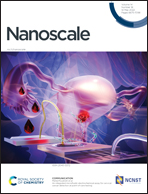An ultralight, elastic carbon nanofiber aerogel with efficient energy storage and sorption properties†
Abstract
The fabrication of ultralight strong carbon nanofiber aerogels with excellent elasticity is still a challenge. Herein, 3D mesoporous graphene/carbon nanofibers (G/CNF) were prepared for the first time from polyacrylonitrile/poly(4-vinyl phenol) (PAN/PVPh) electrospun fibers. Through hydrogen bonding interactions between PAN and PVPh polymer chains, traditional soft carbon nanofibers can be converted to form hard nanofiber aerogels with excellent mechanical, electrical, and sorption properties. The specific interactions among PAN/PVPh led to the formation of porous features on carbonized nanofiber foams. The 3D carbon foams are extremely elastic, strong, and light in weight, and they exhibited super oleophilic and fire-resistance properties. Electrochemical studies indicate that the G/CNF foam achieves a capacitance of up to 267 F g−1 (at a scan rate of 1 mV s−1), with an energy density of 37.04 W h kg−1, exhibiting better electrochemical performance than other reported porous carbon devices. In addition, the G/CNF foam also exhibits sorption capacity towards various organic solvents and oils. This study paves the way toward a new class of lightweight and robust porous carbon nanocomposites for application in electrochemical energy storage systems and oil sorption devices.



 Please wait while we load your content...
Please wait while we load your content...